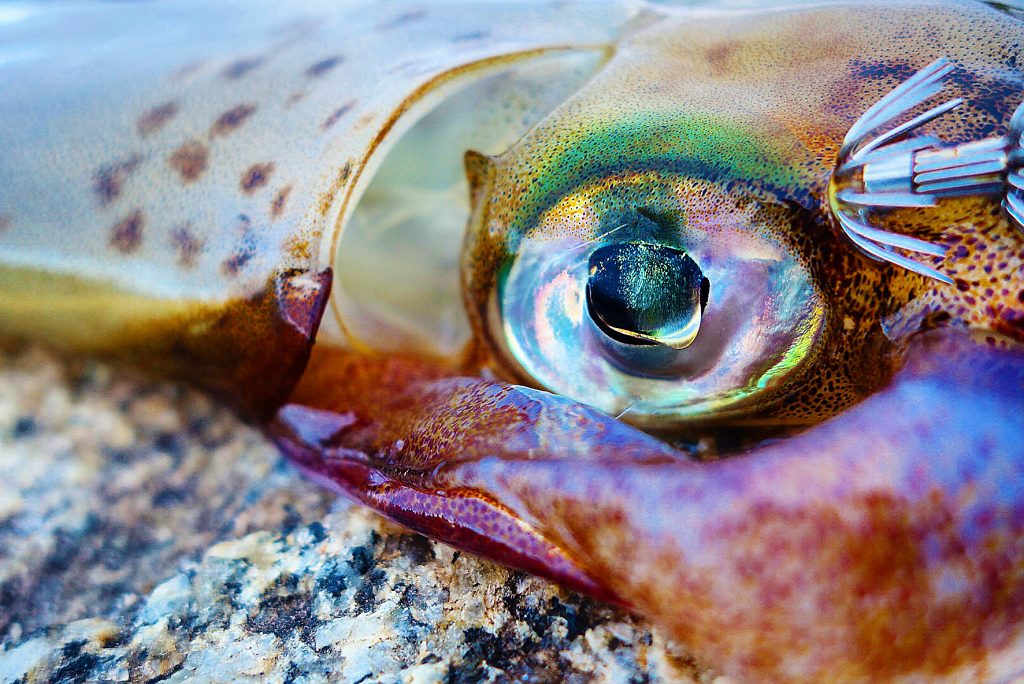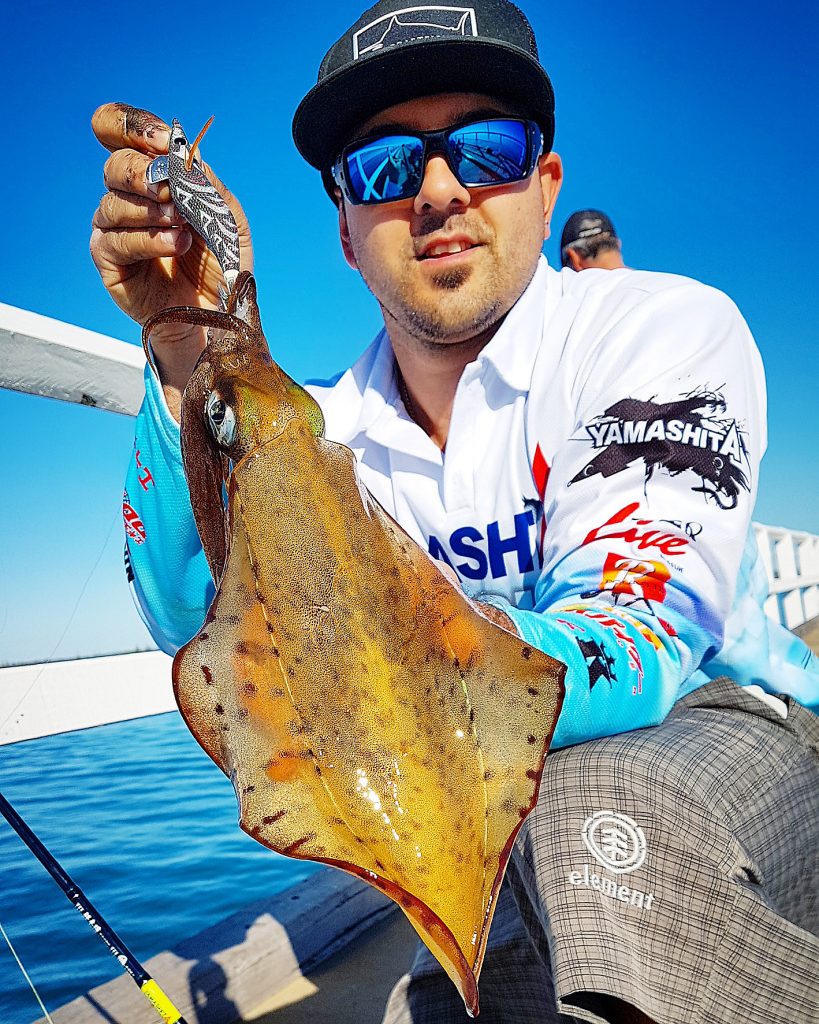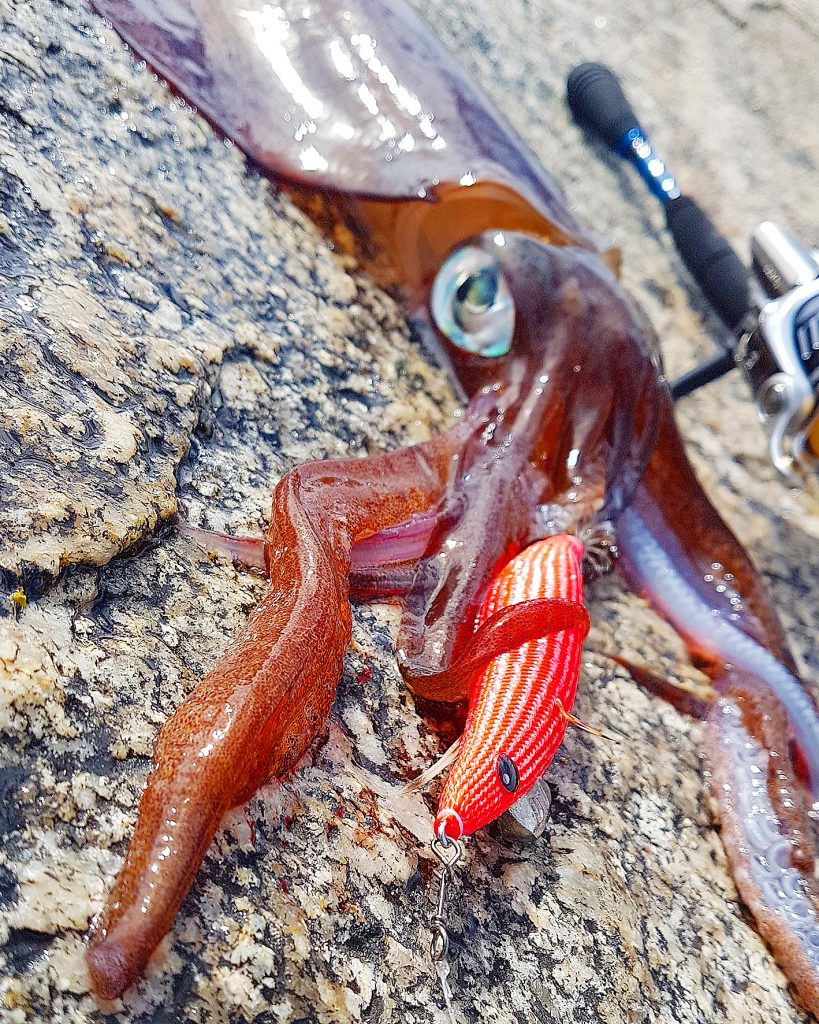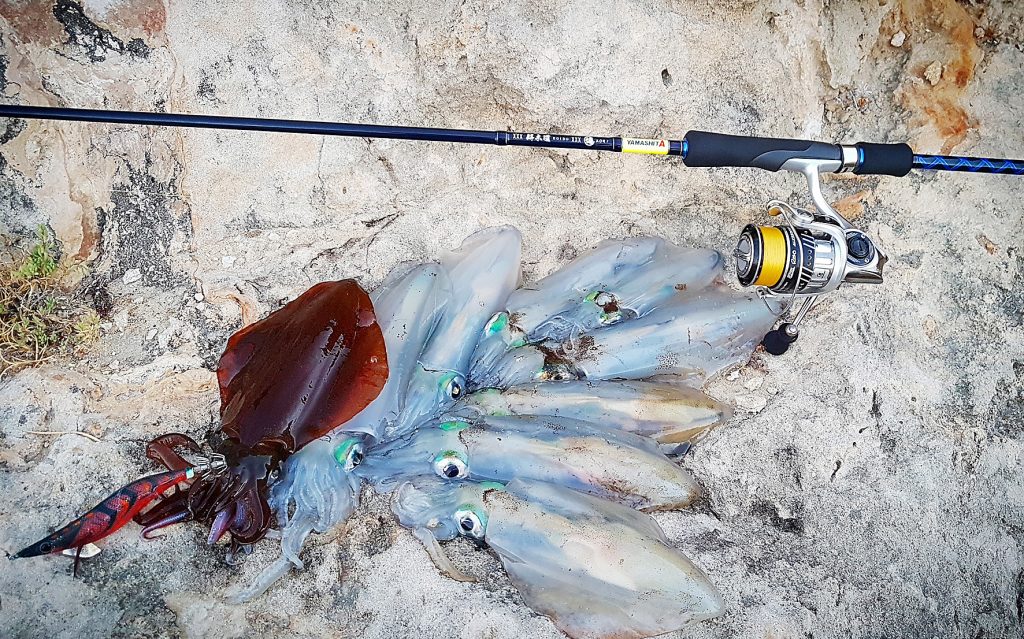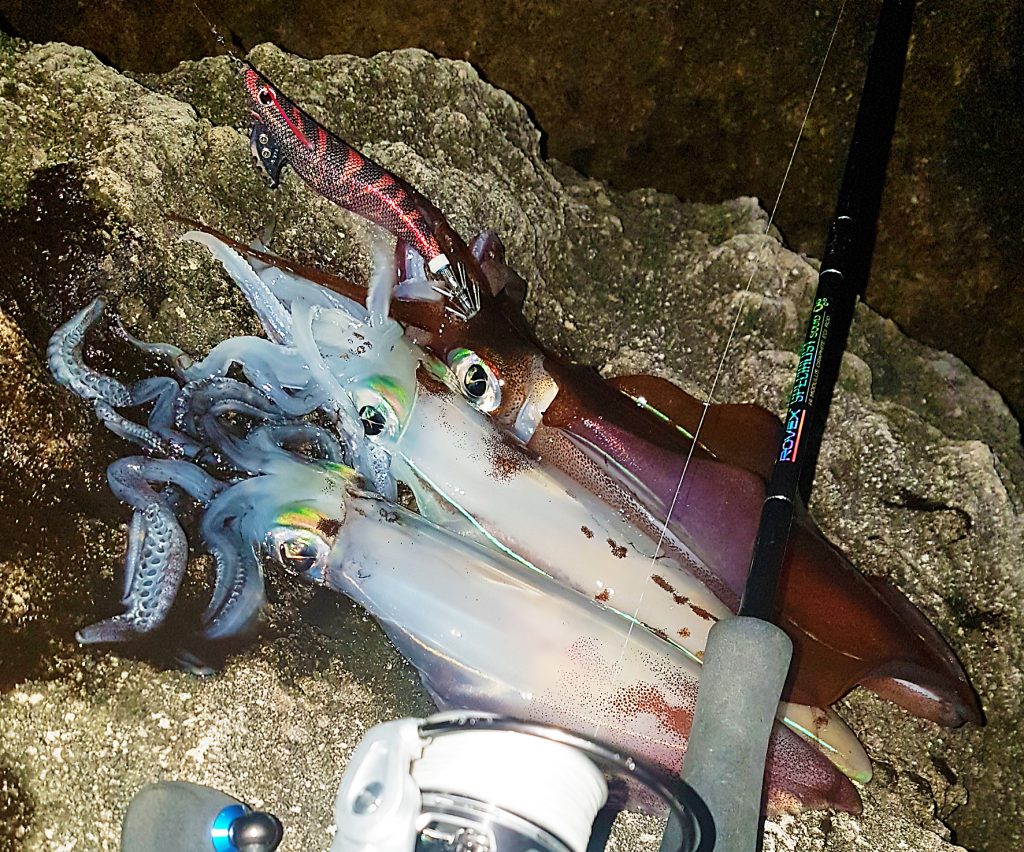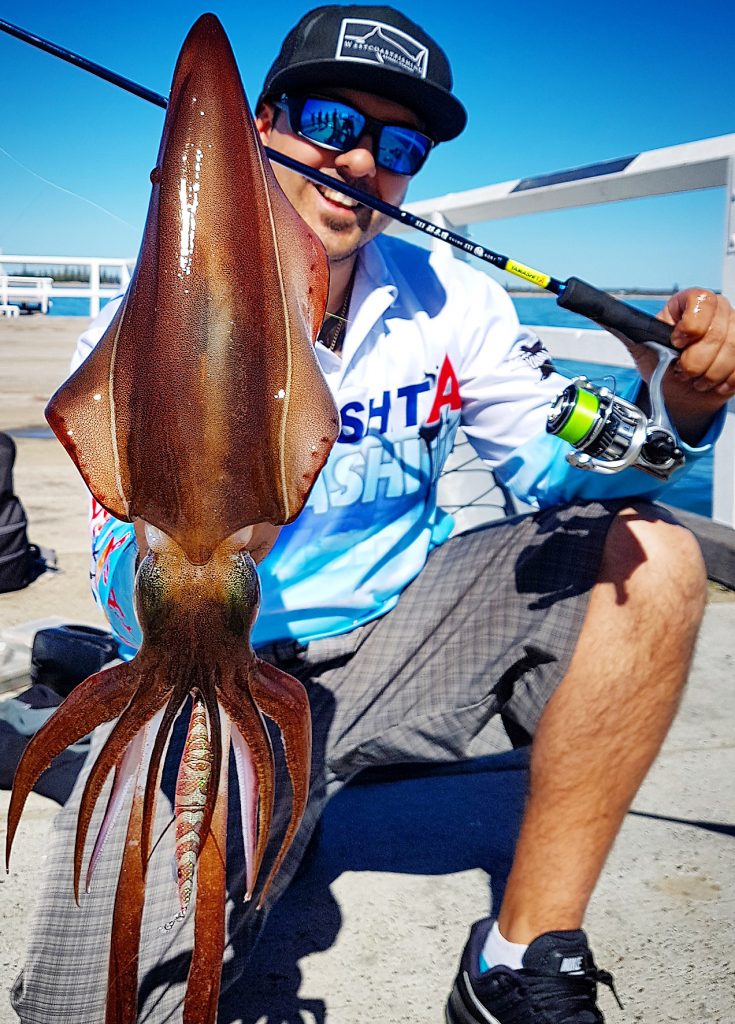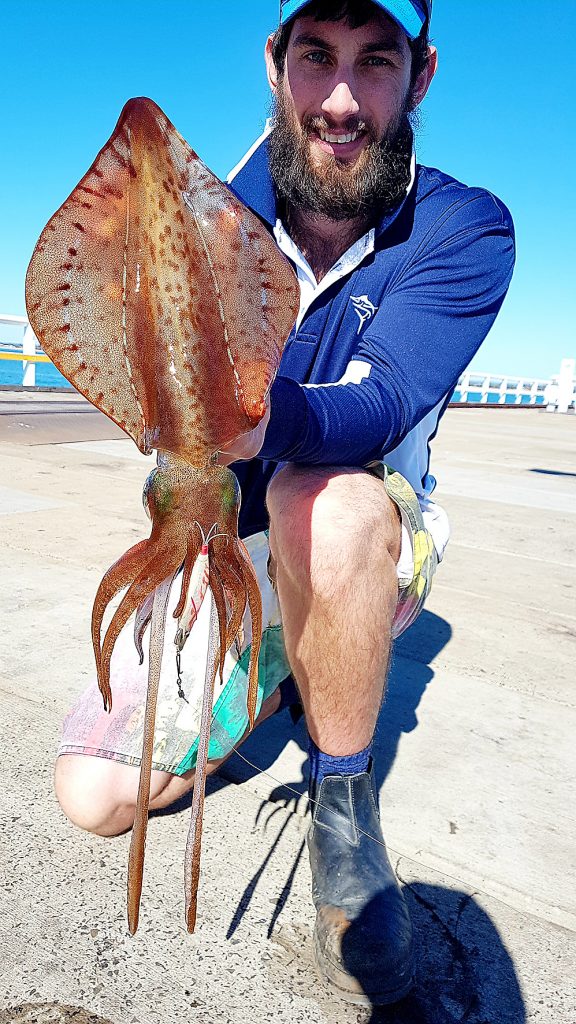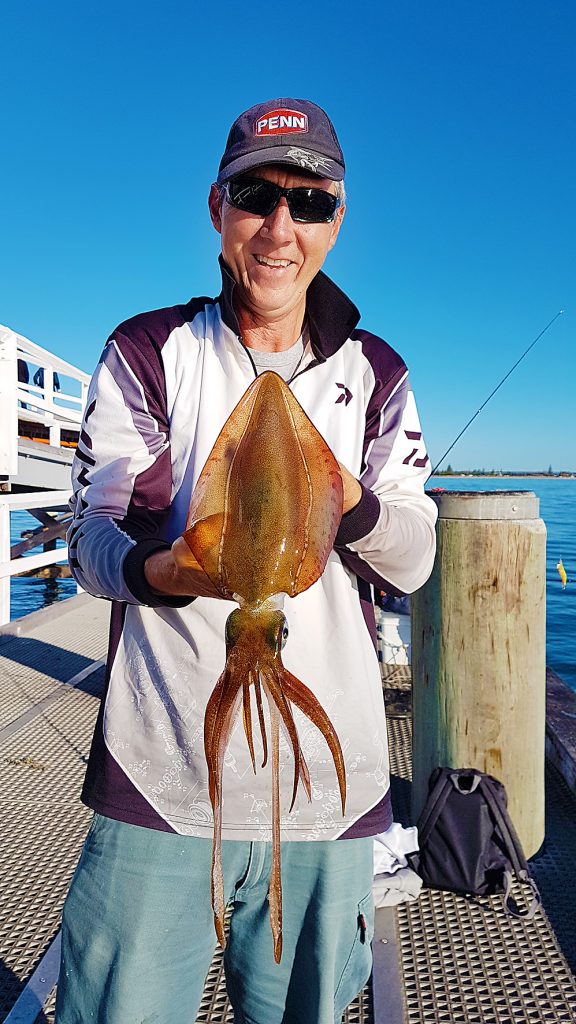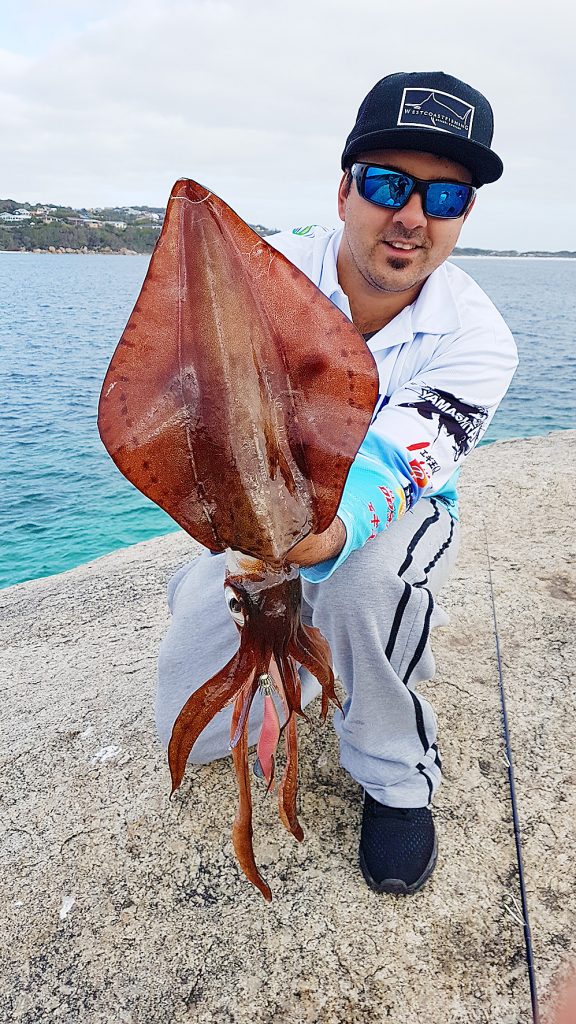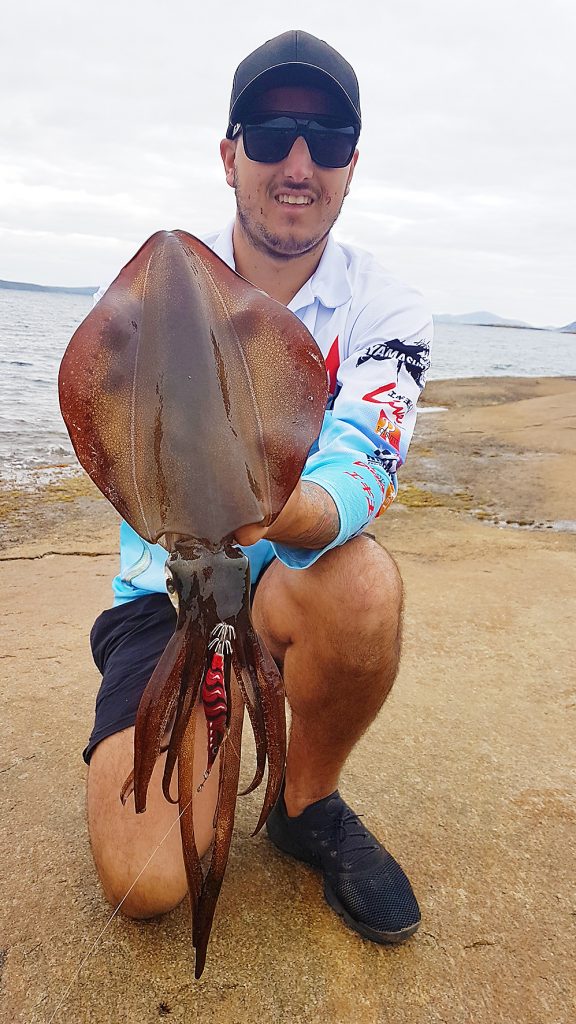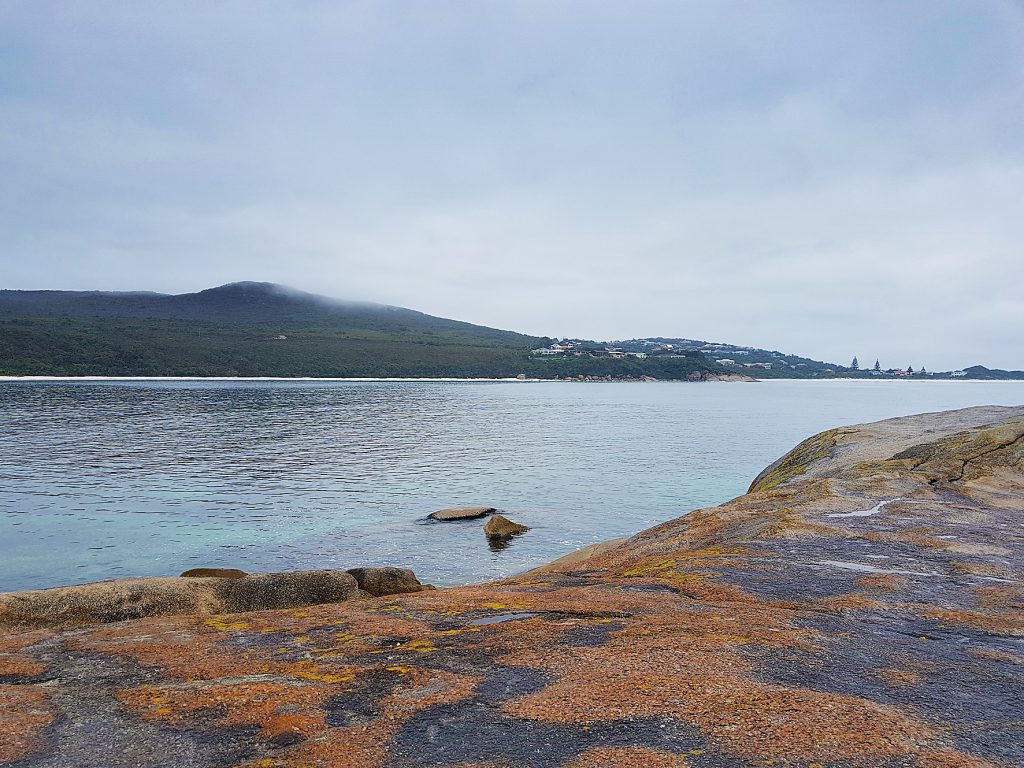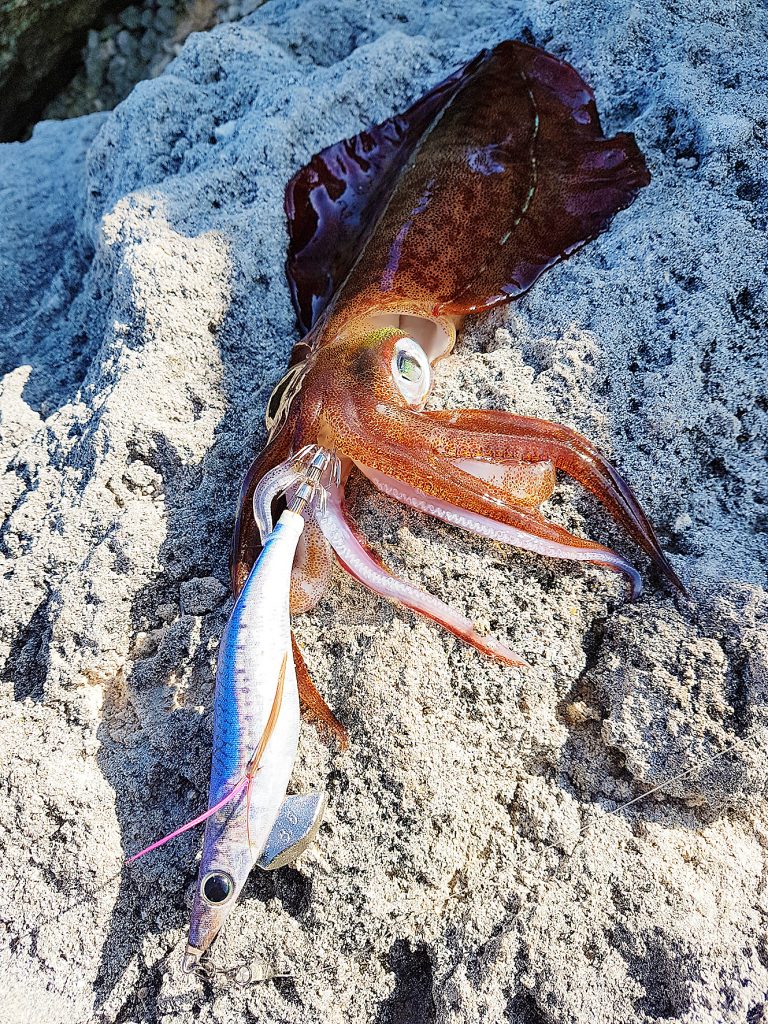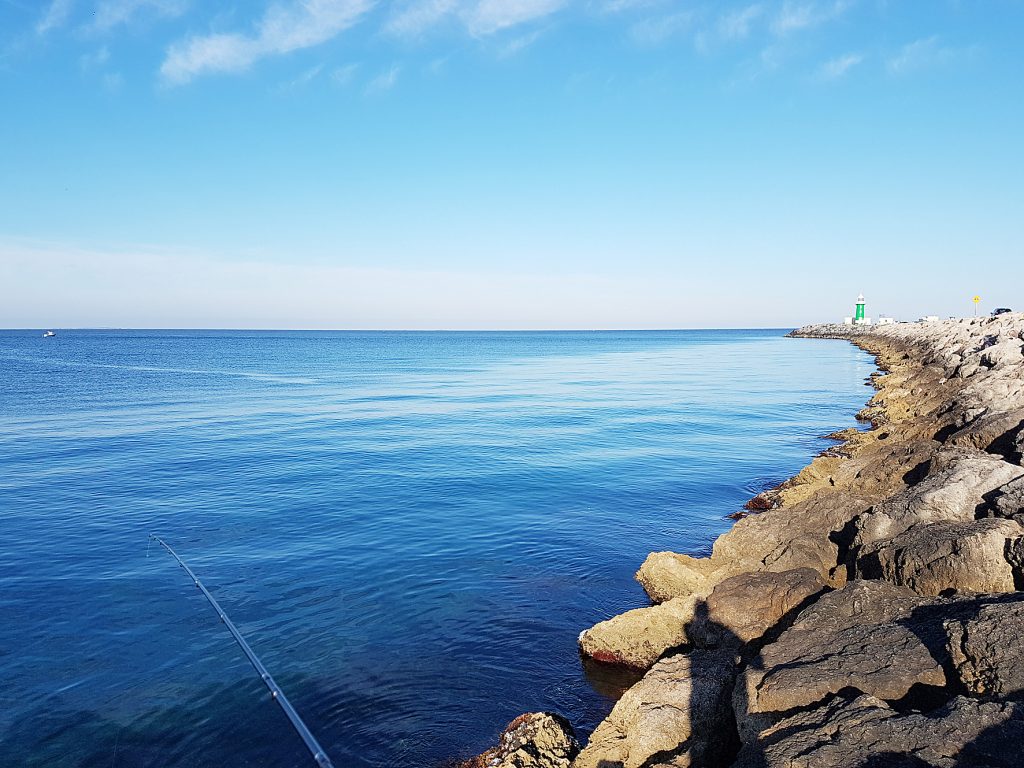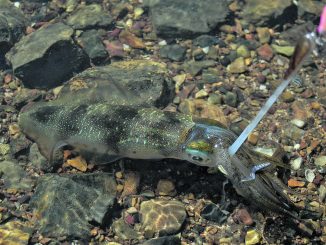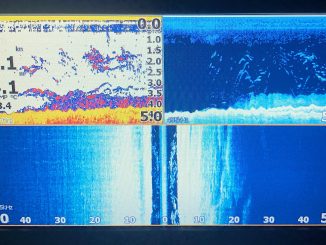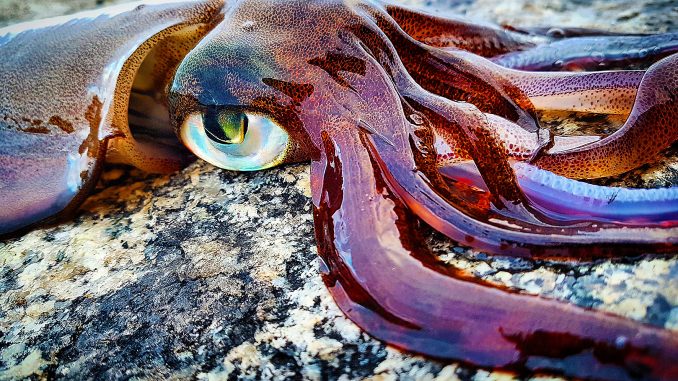
by Jacob Crispe •
This article will cover all the things an angler should think about when trying to catch squid land-based – everything from choosing the right rod and accessories, right through to what to look for when identifying a good squidding spot while staying safe at the same time. We will also touch on jig colour and type selection to suit different conditions that can vary between spots on any given day, plus techniques and more!
Rod selection
There are a couple of things that come to mind when choosing the right rod: the size of the jigs, and the distance of the cast needed to get the best results at the desired locations.
Knowing this will help determine whether you need a short, soft action rod around 7-7’6” long with a light to medium light action rating for smaller jigs for a closer cast radius. Jetties are a great place to use shorter rods because a long cast is not usually needed. The jetty’s pylons commonly attract baitfish, which in turn can bring active hunting squid to the area.
If the locations you want to target are from rock groynes or natural rock ledges, where good looking grassy patches are a lot further out, this is where a longer rod with a firmer action is required. The heavier action rod will allow you to use larger and heavier jigs and achieve a much longer cast. In this case, the best rod to use would be around 8’3”-8’6” in length with action ranging from medium light right up to medium heavy. Keep in mind these are specialised egi rods that are designed and tuned for casting specific jig weights. An egi-specific rod will always outcast and outperform a standard style spin rod when squid fishing.
Reel, braid and leader selection
Reels around the 2000-3000 size are best suited to egi rods, and maintain a nice lightweight and balanced combo that will make your experience a lot more comfortable and enjoyable. Matching your reel with a good quality thin diameter braid is the next key factor you need to take into consideration. This will really help achieve a much longer cast to reach your desired spot – or you can just cast as far as possible and reach what is known to land-based anglers as ‘virgin ground’. It is called this because a majority of people can’t normally reach these areas from land with standard rods and reels and lines.
When choosing your braid strength, keep in mind that your jigs can sometimes be worth up to around $30 apiece, so you don’t want to use any braid under 10lb in case you get snagged in the weed. If you get snagged you need good line strength to try and pull your jig out without breaking and losing your jig. The preferred line strength would be between 10-16lb with the thinnest diameter possible.
Your leader line of choice should never be less than the breaking strain of your braid, so I generally use a 15lb monofilament or fluorocarbon to maintain good strength and abrasion resistance.
Ultimately, it’s all about getting your set-up matched perfectly between three things: the rod, the reel and the braid. This combination, when tuned, will greatly increase your chances of making a longer cast and catching more.
identifying good locations
When you are looking for new locations to target, there are a couple of invaluable tools needed for the job. The first is a smartphone and the other is a quality set of polarized sunglasses.
Keep it simple. Looking at Google Maps on your phone is a great way to figure out areas that you may not be too familiar with, especially when travelling. When doing this, one of the main things to look for is large weed and sea grass areas with visible sand patches amongst it. These types of locations can be commonly found in most bays and harbour type areas, and are referred to as ‘broken ground’. If you aren’t sure what this looks like, jump on your phone and type in ‘Princess Royal Harbour’ or ‘Frenchman Bay’, which are both in Western Australia. Zoom in and look at the shallower areas where it’s a lighter green and patchy colour. This is the kind of thing to look for in your local area.
When you’re on location, a good set of polarized sunglasses is a must to help reduce glare and identify exactly where the most appealing weed and sand patches are. By doing this you can really home in on your targeted areas while also maintaining the best vision. You may be able to spot squid following your jig, where you can adjust your action to entice them. You may even spot a free swimming squid, where you can sight cast for a hook up. This can make your experience a lot more fun.
Tides can also have a part to play when considering which location to try. There are a lot of areas that may become too shallow on a low tide, making it difficult to target without losing too many jigs. In this case, a high tide will be essential to maximising your catch rate with minimal jigs lost to snags.
If you are walking around a new area looking for good places to try, keep an eye out for ink stains. If you can see a lot of ink on the rocks or jetty, you are definitely in the right area.
Knowing where baitfish regularly gather can help you out a lot. Whatever species you are chasing, if you find the baitfish you will generally find the predators that feed on them. One spot where they are easy to find is any jetty at night with lights on – a prime location for targeting squid at night. Not only are fish and squid attracted to light, but so are insects, and when the insects fall into the water it can entice small fish and squid to feed on them. At a young age I witnessed this happen at the old wharf in Albany with my father. It was always a well lit place with very bright lights, and on this particular night there were so many moths attracted to the lights they were falling onto the water where we watched squid and fish fighting to get to them first. It was easy pickings for everyone who was there that night.
My favourite spots are South and North Mole, and I often go there before or after work where it’s not too hard to catch a feed. Often I’ll drive south to my home town of Albany and fish for larger species, but I always end my trip down there in the harbour beaches or bays that are easily accessible, and which always produce good-size squid. Another gem that is only a short drive from Perth is the Busselton jetty; this is a great spot that makes for a nice day or night out, and can produce good numbers.
Best times to go
First and last light are always the best times to fish for squid. Usually, getting up early and getting out there before the sun comes up is a great way to start, because the squid are very active through this period. This also allows you to go through your jig base colours on the light change as the sun is coming up. Generally, the best way to go is to start with glow-in-the-dark and then change through different reds to purples, blacks and oranges in the low light. You can switch to more natural patterns with clear, silver and gold in bright, sunny conditions.
The last light of the day is in the exact opposite sequence. You should start with silver and gold while the sun is up, then orange, red, purple and blacks while the sun goes down, and then lumo as it gets dark.
Solunar and tide changes are another great thing to consider when choosing a time to go. If you get a tide change in the same period as a light change, you can usually expect big things – and if there are tidal changes in the middle of the day, it’s still a good time to fish. You can catch squid at any time of day, not just in the peak times. As long as you have a line in the water, there’s always a chance of catching one.
Jig types and techniques
There are a range of jig types and sizes available to suit different depths and currents. As a general rule, 3.5 size shallow types have an average fall rate of 5-6 seconds per metre, while 3.5 basic types have an average fall rate of 3-3.5 seconds per metre and 3.5 deep types have an average fall rate of 1.8-2.2 seconds per metre. These sink times may vary between jig sizes, and you can usually find all this out on the packet.
For better results, you need to learn how deep the water is. If you can see the bottom and there’s not too much water movement, your basic type jigs are a good choice to start with. If you are standing on a jetty you can start by dropping your jig straight down, and it will always fall at a 45° angle. Count how long it takes to reach the bottom. By doing this you have learnt exactly how deep the water is by the jig’s sink rate time.
If you are standing on rocks or beach, you can do this by counting down on your first cast. As an example, if you have counted 20 seconds before your jig reaches the bottom, then with your next cast you should start counting again as soon as your jig hits the water. If you count to eighteen or nineteen before beginning your retrieve, then you know you are right down in the strike zone where 90% of the action happens.
When it comes to technique, there is no right or wrong. In the early days most people would cast their line and just let the jig sink a little bit before starting a slow retrieve, but nowadays squidding has become more of a culture and is being taken a lot more seriously. A very helpful tool for learning techniques is the internet. There are great techniques coming from Japan, and I have learnt a lot over the years by watching videos on YouTube, especially those made by Yamashita featuring an absolute master of squidding, Eisuke Kawakami. Eisuke is still releasing a lot of videos on YouTube, showing people exactly how to master the art of squidding.
The main technique most people are now adopting is a basic jerk style action. The angler will cast, count the jig down into the strike zone and then, once the desired depth is reached, give two to three sharp whips or jerks with the rod while winding the slack line between each jerk. With each jerk or whip action the jig will dart up to 90° from left to right while sliding forward and upwards at the same time. After a few whips of the rod you pause and allow the jig to fall back down towards the bottom again. It is often on the drop where you get the most strikes.
The more you practice this the easier it will get, and over time you’ll find yourself customising your technique to suit different scenarios. Remember there is no right or wrong – just keep it simple and try to stay comfortable at the same time. That way, the time you spend on the hunt will be a lot more enjoyable.
If you’re targeting a shallow area where the water is no more than 3m deep, a shallow type jig is the go. This jigs take almost twice as long to sink, which gives you double the hang time. It can increase your chances of a strike before your jig can hit the bottom and potentially get snagged or pick up weed, which can deter squid from attacking.
When you’re working your shallow jigs, be a little gentler on the whip action; these jigs are much more buoyant and lift a lot easier through the water, meaning you can work your jig more slowly and gently. If you were to work a basic style jig in this same depth you’d have to work your jig a lot quicker, meaning less time between each set of jerks to keep your jig off the bottom. Sometimes this technique can entice squid to attack even more fiercely though, as the jig mimics a fleeing baitfish or prawn.
Deep style jigs are best used when you are faced with a lot of water movement or current, where you may have trouble reaching the bottom with a standard basic jig. For example, if you cast a basic style jig out onto a small target area, by the time your jig reaches the bottom it may be 10m to the left or the right of where you first landed. A deep jig, by contrast, will sink vertically, putting you on the targeted patch a lot quicker and maximising your chances for a good catch rate.
The other time to use a deep jig is if the water is a lot deeper than anywhere you would normally use your basic jigs, as it will reduce the waiting time to reach the bottom.
TIP: Always aim to have the wind at your back. This will help you to cast further and will prevent your slack line being pulled to the side on the drop.
COLOUR SELECTION
There are so many different jig colour combinations that choosing the right one can be overwhelming. However, once you know what to look for you’ll find the task a lot easier.
The three main things to take into account when selecting jig colour are the base colour, tape/foil (the reflective layer underneath the cloth), and cloth colour. Each combination suits different conditions.
Base colour
• Glow – best suited for low light or dark conditions;
• Clear – best suited for bright conditions where it gives a natural appeal;
• UV glow – best suited for deep water or cloudy weather; and
• Rainbow glow – excellent when cloudy or rainy, or in dirty water.
Tape/foil colour
• Silver and gold – works well on both sunny and cloudy days;
• Red and pink – great all-rounder colours, best suited to murky water and low light;
• Purple – versatile for day and night, a stand-out in low activity, and provides a strong silhouette in low light;
• Orange – a great all-rounder, especially when squid are highly active and in low light; and
• Rainbow – another great all-round colour as it has a range of hues.
Cloth Colour
• Pinks and oranges – the best all-rounders;
• Red, violets and bright greens – a great choice for low light and murky water;
• Browns, dark greens – great for cloudy days and clear water;
• Naturals , clears and blues – best for sunny days with clear water; and
• Black – a great all-round colour, and a stand-out for low light as it throws a strong silhouette.
Remember that there’s no right or wrong – these colours are just guidelines to help increase your chances.
Conclusion
As a land-based angler you should travel light, bringing only the essentials. By doing this you’ll be able to stay mobile, and can cover more ground on foot while carrying everything you need.
If you’re just starting out, all you need is a good backpack where you can store your jigs and accessories. And remember, the only thing you want in your hands is your rod and reel, as this will allow you to keep casting while on the move. Also, depending on the location, you may need a net or a squid gaff, which you can clip to your backpack or body while you’re moving between locations. A gaff is best suited to locations that are high above the water, such as jetties and steep rock ledges, while a net is best suited to low sloping rocks or low jetty platforms.
Handy items include egi clips (a must-have for quick and easy jig changes), braid scissors, UV torch (for charging glow jigs at night), ike jime squid spike (for fast, humane killing of squid), large snap-lock bags (to store squid in the backpack without a mess), and a rag or hand cloth.
STAY SAFE
Lastly, remember that safety should always come first when you are fishing. Be aware of your surroundings, never step on slippery surfaces, and never step on wet rocks, especially wet black rock. It’s advisable to wear a PFD, especially when fishing off rocks, and you should always let someone know where you are going and when you expect to be back.
I hope that within the information in this article you have found something helpful to increase your chances of more success to catching squid in the future.

